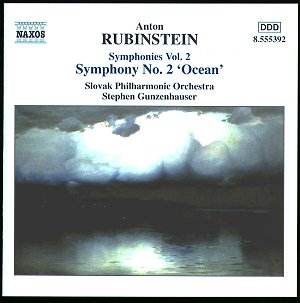 |
Anton RUBINSTEIN (1829-1894) Crotchet
AmazonUK
AmazonUS |
RUBINSTEIN is well known to us as an outstanding Russian pianist who rivalled and even outshone Liszt, but is less well known as a composer. Cui unfairly wrote of him not as a Russian composer but "merely as a Russian who composes". It is true that his style of composition failed follow the Russian traditions of Balakirev, Borodin, Mussorgsky, Rimsky-Korsakov, or Cesar Cui (the famous five, Kouchka or might handful). His skills as a child virtuoso pianist had brought tours of Scandinavia, Austria, Germany, London and Paris and wide exposure to European music. The family settled in Berlin where Rubinstein took lessons in counterpoint and harmony from Glinka's former teacher, Dehn. This led him to follow the German school in style of composition. Returning to Russia he became director of the St Petersburg Conservatorium until 1867 and he turned his back on composing in the style of the nationalistic style of his Russian contemporaries. As the son of German-Jewish parents (who had chosen to become Christians) he shared a similar background to Mendelssohn and was strongly influenced by his style of composition.
The Symphony No. 2 in C Major is an unusual symphony in that it contains seven movements, the result of revision and re-revision by Rubinstein over a period of 29 years. Initially, in 1851 the symphony was written in four movements. As more ideas flooded into Rubinstein's mind the work was extended until the present form resulted in 1880. He paints a vivid musical scene of the sea, full of mood and atmosphere. The result is a well-crafted piece, first written at a time when Rubinstein was in St Petersburg, being supported by the Grand Duchess Elena Pavlovna, sister-in-law of the Tsar. The early movements of the work are strongly influenced by Mendelssohn. Its structure is strong, but unlike the memorable themes and dynamic rhythms evident in his first symphony. The Ocean Symphony combines strong orchestral texture and colour and displays considerable technical skill in its writing. This is no Fingal's Cave yet the energy of waves and swirling oceanic currents are clearly represented in the piece.
A light and atmospheric opening (Moderato assai) gives the immediate feel of a tone poem's graphic imagery and sets the scene of an energy-filled seascape, presented in characteristically Mendelssohnian style. In the movement Rubinstein demonstrates his command of rich orchestral writing with a spontaneity of treatment using interesting woodwind phrases.
A dark Lento assai then follows with stirring sounds of turbid effervescence which provide an element of sinister foreboding. An air of mystique builds in strength, during clever orchestral dialogue between wind and strings, to provide a storm of fierce intensity. Basses and celli hover with strong murmurs of discontent whilst chromatic runs of strings, flute and piccolo weave threads of artistic meteorological wonderment before a calm eventually descends on the angry ocean. vTo follow such energetic forces an Andante carries an delicate pastorale used by Rubinstein to give a contrast and change of direction in the Symphony. One can imagine a picturesque and tranquil seascape basking in the warmth of the day. Undercurrents of oceanic currents represented by celli runs are still present but do not suppress the calmness of bobbing boats silhouetted in refracted sunlight.
An Allegro, rather scherzo-like, introduces a hint of Russian melodic invention which might have come from the pen of Tchaikovsky.
A particularly moving Andante now follows, carrying a strong romantic theme set against a rippling accompaniment of running triplets; a hybrid of Smetana's Moldau and Mendelssohn's Italian, perhaps.
A bright Scherzo provides a sailor's dance, possibly of Russian folk origin, before the movement relaxes into a gentle Trio.
The finale, Andante, is a long movement which opens with a return to the first subject with a meandering theme. It then flows into a bright rhythmic theme, which opens out with brass to possibly give the splendour of a majestic galleon arriving in port to the warm reception of its townsfolk.
Despite echoes of Tchaikovsky in the first, second and fourth movements, both in harmony and orchestral texture, there is little characteristically Russian about this splendid work by a Russian composer.
This disc is Volume 2 of Rubinstein's Symphonies, a reissue of a recording, which first appeared as a Marco Polo release, 8.220449. Marco Polo brought out a series of five of Rubinstein's forgotten Symphonies and two Concertos for Piano & Orchestra. (See note below.)
The CD recording is of excellent quality. The orchestra playing under Stephen Gunzenhauser is superb. He studied at the New England Conservatory and served under Leopold Stokowski before becoming artistic director of the Wilmington Music School. His recordings for Marco Polo/Naxos have included works by Schumann, Tchaikovsky, Dvorak and Liadov.
The disc carries good notes on the composer and brief notes on the work in English, French and German.
Raymond Walker
++++++++++++++++++++
Rubinstein Symphony CDs
Symphony No.1, Slovak PO/ Stankovsky Naxos 8.555476
Symphony No.4, Czech PO/Stankovsky Marco Polo 8.223319
Symphony No.5, Bucharest George Enescu PO/Andreescu Marco Polo 8.223320
Symphony No.6, Phil Hungarica/Varga Marco Polo 8.220449
It is likely that the other Marco Polo CDs will be eventually reissued on Naxos